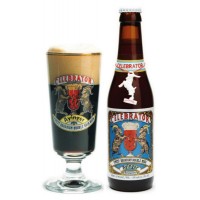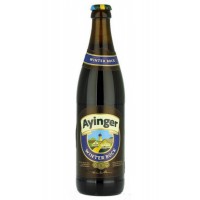Comprar Ayinger Celebrator - Schloss Eggenberg Samichlaus Classic - Ayinger Winter Bock
Ayinger Celebrator Doppelbock
A beer that has a dominant malty taste. This beer’s origins in a monk’s recipe are reflected in its heartiness. The Pope of Beers, Conrad Seidl, describes it as: “Almost black with a very slight red tone, a sensational, festive foam and truly extraordinary fragrance that at first summons up visions of greaves lard. The first taste is of mild fullness with an accompanying coffee tone, which becomes more dominant with the aftertaste. There is very little of the sweetness that is frequently to be tasted with doppelbock beer.” The Ayinger Celebrator has been ranked among the best beers of the world by the Chicago Testing Institute several times and has won numerous medals.
------------------------------------------------
Lager Doppelbock Bock Tostada. El color es caoba profundo con reflejos rojo rubí. Presenta espuma sólida. Aroma a nuez y un toque de cedro. Notas tostadas. Sabor mucho cuerpo. Tostado, afrutado a malta.
El Beerpope Conrad Seidl, la describe de la siguiente manera: "Casi negro, con tono ligeramente rojizo, una espuma sensacional, sólida y un olor muy raro, que recuerda a la primera manteca.
Celebrator Ayinger se ha clasificado en varias ocasiones por el Instituto de Pruebas de Chicago en el número de las mejores cervezas del mundo y ha ganado numerosas medallas.
Schloss Eggenberg Samichlaus Classic
Cerveza especial fuerte, austriaca, 14% de alcohol, de baja fermentación.
De color rojizo, aromas a Coñac, cuerpo firme, tiene toques de cereza y crema catalana, con un caluroso final a especias y pimienta.
Samichlaus es la cerveza de baja fermentación más fuerte del mundo. Aunque puede variar de un año a otro, siempre tiene como mínimo un 14% de alcohol; algún año llegó a tener casi el 15%. Una vez elaborada -el 6 de diciembre- y fermentada por primera vez, pasa por una lenta segunda fermentación en tanque a baja temperatura (lagering) que dura un año. De vez en cuando pasan la cerveza de un tanque a otro para reavivar la segunda fermentación.
Después de embotellada aún puede envejecer durante años en la botella.
Conseguir una cerveza de 14% a base de fermentación es casi imposible, porque la levadura que trabaja en los mostos de cerveza suele morir al alcanzarse un porcentaje de alcohol del 11-12%. El cervecero de Hürlimann se dedicó durante años a seleccionar sus levaduras para que fueran capaces de resistir estas condiciones especiales, consiguiendo de este modo esta cerveza tan potente.
La Samichlaus no es una cerveza normal, por lo que resulta muy difícil combinarla con comida. Se considera más como un brandy, de postre como copa y con chocolate negro!
Ayinger Winter Bock
The recipe for this beer goes right back to monastery traditions. The complex triple mash process using four types of malt gives the dark “doppelbock” its characteristic malty dominance and its close to black color. The storage time of 16 weeks produces a pronounced, well-rounded taste. Despite a high original wort content, the sweetness that is frequently present with doppelbocks can scarcely be detected. The first taste is of mild fullness with an accompanying coffee tone, which becomes more dominant with the aftertaste. Between November and January you can allow yourself to be completely won over by the excellent quality of the Winter Bock.
- Dos Equis (XX) Lager Especial - Carta Blanca - Heineken
- Turia Märzen - Pilsen Ambar - Voll-Damm
- Cucapá Runaway - Microbombolla Heidi - Microbombolla Galaxy
- Maeloc Sidra Extra Ecológica - Maeloc Hard Cider Sweet / Sidra Dulce - Maeloc Sidra con Fresa
- Jester King Gotlandsdricka - Cuvée De Ranke - Collective Arts Dry Hop Sour
- Cordobeer Trigo - Ebora Rubia Mediterránea - Lefebvre Blanche de Bruxelles
- Barret TAM Couvee - Barret Kabuto - Barret Kabuto Barley Wine
- Stone Imperial Russian Stout - Flying Dog Raging Bitch - Founders KBS Kentucky Breakfast Stout
- Mont St. Aubert - Brunehaut Blanche Organic & Gluten Free
- Carrefour Cerveza Holandesa Premium Quality - Argus Tostada - Steinburg Negra Dark
- Tecate - Carta Blanca - Coors Light
- Brutus - Bourgogne Des Flandres Brune / Bruin - Aktien Zwick’l Kellerbier
- Heineken - Erdinger Weißbier / Hefe-Weizen - Erdinger Dunkel
- Dorada Especial - Dorada Especial Roja - Dorada Especial Esencia Negra
- Kasteel Rouge - Delirium Red - Eagle Brewery Banana Bread Beer
- Heineken - León
- Malheur 4 - Moinette Blonde - Lupulus Hibernatus
- Trappist Westvleteren 8 - N’Ice Chouffe - Reinaert Grand Cru
- Ambar Export - Belcebú Apocalipsis - Alhambra Reserva Roja
- Amstel Oro 0,0 Tostada - Estrella Damm
- Estrella Galicia Especial - Estrella de Levante Clásica - Paulaner Oktoberfest Bier
- Miller Brewing Company Miller Lite - Miller Genuine Draft
- Estrella Damm - Voll-Damm - Damm Lemon
- Catalan Brewery Pumpkin - Shepherd Neame Bishops Finger - Virtus / Black Bitch Black Virtus Vanilla Milk Stout
- Ambar Export - Voll-Damm
- Samuel Adams Boston Lager - Quilmes Red Lager - Coisbo 5th Avenue
- Budweiser - Paulaner Hefe-Weißbier / Hefe-Weizen / Weissbier - Heineken
- Corona Extra - Tecate - Cerveza Sol
- Cruzcampo Pilsen - Alhambra Tradicional - Estrella Galicia Pilsen
- Wittekerke Rosé - Petrus Nitro Quad
- Estrella Galicia Pilsen - Amstel
- Dorada Especial - Voll-Damm - Estrella Damm
- Alhambra Reserva 1925 - Argus Especial
- Barbière Belgian Amber Ale - Quijota Septemberfest - El Oso y el Cuervo Oso Urraco
- Estrella Damm - Moritz - Cruzcampo Edición Especial Navidad 2017
- La Axarca - Reptilian IBUprofano
- BrewDog Dead Pony Club - BrewDog Belgian Trappist - Brewdog Tokyo *
- Hofbräu Dunkel - Erdinger Dunkel
- Amager Hr. Frederiksen - Amager / Surly Todd The Axe Man - Amager / Nøgne Ø The Gay Gondolier
- Naparbier Undead Imperial IPA - Deorus Wing Chun Legacy - Brewdog Hardcore IPA
- Estrella Galicia Especial - Carrefour Cerveza Holandesa Premium Quality - Amstel
- Yakka Lunática Bière de Valerie - Modern Times Fruitlands Passion Fruit & Guava
- Modelo Especial - New Holland Dragon’s Milk - Goose Island Beer Co. 312 Urban Wheat Ale
- Estrella Galicia 1906 Reserva Especial - La Milnueve - Tropical 1924
- Kunstmann Bock - Kunstmann Unfiltriert Lager Sin Filtrar - Kunstmann Honig Ale Cerveza Miel
- Estrella Damm - Keler - Voll-Damm
- Heineken - Bitburger Premium Pils - Carlsberg
- Wild Beer Scarlet Fever - Adnams Ghost Ship - Anarchy Done Time
- Samuel Adams Winter Lager - Samuel Adams Boston Lager - Samuel Adams Cranberry Lambic
- Samuel Smith Taddy Porter - Beavertown Black Betty - Thornbridge Chiron
- Solera Light - Solera Clásica - Corona Extra
- Mikkeller Hoppy Lovin’ Christmas - Mikkeller Single Hop Nelson Sauvin IPA - Mikkeller Session IPA Mosaic Gluten Free
- Nel Sant Joan - Cumbres Maracumanto - Craftsman Pale Ale
- Duvel - Filou
- CCVK Obus - CCVK 28038 - Speranto / No Nation / CCVK Perros Lupuleros
- Emelisse Urtype Pilsener - La Trappe Quadrupel
- Ilda’s Ros - Ilda’s Clot
- Estrella Damm - Polar Pilsen
- Gatgraz Sperman Homenots - Tallgrass 8-Bit Pale Ale - Naparbier Odín
























